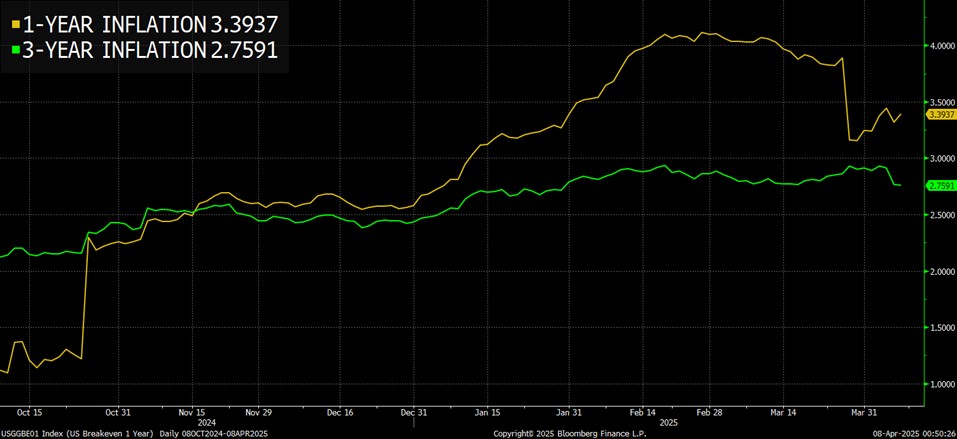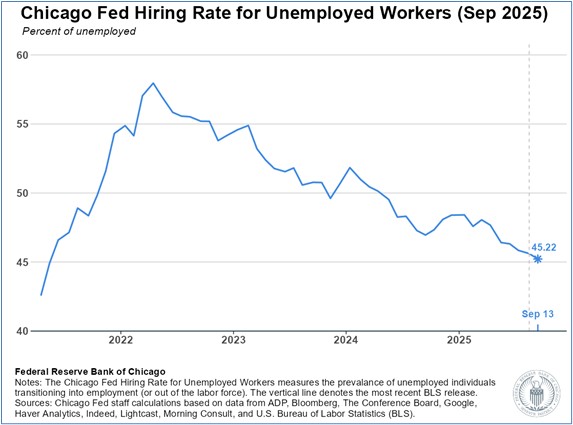Monthly Interest Rate Update
Fed officials are divided on future rate cuts amid distorted economic data and upcoming leadership changes as Powell’s term ends. Consumer sentiment is weakening, and bond markets show caution with widening spreads and heavy tech debt issuance. Markets expect one more rate cut this month, but the outlook beyond that is uncertain. Treasury yields remain lower year-to-date, and rates are likely to stay flat to slightly down until clearer data and new Fed direction emerge in early 2026.
Federal Reserve officials are signaling increasing disagreement about the pace of future rate cuts as post-shutdown economic data remains distorted and inconclusive. Rates are fairly steady, but with the end of Powell’s tenure as Fed Chair approaching, affordability rising as a political and economic issue and bond markets flashing caution, the outlook is getting cloudier.
- Jay Powell’s term as Fed Chair expires in May and his replacement is expected to be nominated in January. Kevin Hassett, a member of the Trump Administration’s and chairman of the Council of Economic Advisors, is currently the odds-on favorite in betting markets. With a similar resume as several recent Fed chiefs, he’s expected to push the central bank in a slightly more dovish direction, in line with Trump’s vocal calls for lower rates. However, he (or an alternate candidate) will have to be careful not to exacerbate inflation with stimulative monetary policy.
- Consumer sentiment has trended downward all year. Persistent inflation, a weaking job market, the disruptive impact of tariffs and a surge in health insurance costs are weighing on consumer confidence, although retail spending has held up so far.
- The bond market is showing some cautionary signs. Non-investment grade credit spreads have widened by 45 basis points, and investment grade spreads are up too, though to a lesser extent. One notable element is the recent surge in debt issuance by tech firms. Meta, Microsoft, Alphabet, Amazon and their peers have raised a record $240 billion this year to support AI-related capital spending. The good news is that this spending is boosting aggregate growth in an otherwise sluggish economy. The bad news for other corporate borrowers, at least in the near term, is that these issues are coming out at wider spreads, crowding out demand for traditional corporate bonds.
The conflicting signals are making it more difficult for investors and traders to predict monetary policy. Currently, futures markets are priced for a quarter-point rate cut by the Fed this month (89% probability), which would be the third such cut of the year. Looking ahead to 2026, the probability of an additional cut in January is just under 50%. By the end of the year, the central tendency is for 75-100 basis points of cuts, but confidence levels are low and there’s a wide dispersion of outcomes priced in.
While medium- to longer-term interest rates have bumped up from their October lows, all the key benchmarks are down for the year. At the long and short ends, 1-month Term SOFR and 10-year US Treasury yields are both down about 50 basis points since the beginning of 2025. Meanwhile, intermediate rates, like 2- and 5-year Treasuries, have fallen nearly 75 basis points. The slope of the yield curve has remained steady since April, with the 2-year/10-year spread still hovering near 50 basis points. The shape of the curve has shifted slightly, with the low point moving from the 3-year yield to the 2-year, though the difference is currently only 2 basis points.
Overall, the outlook is mixed, but rates look like they will stay flat to down for now. The picture should start clearing in the first quarter with more accurate economic data and a better handle on the likely direction of Fed policy under new leadership. As we move through the year, anticipate lower floating rates (two or three cuts), coupled with an uptick on the longer end as inflation persists and the job market stabilizes.
Key Statistics: Interest Rates, Unemployment and Inflation
| Year-end 2021 | Year-end 2022 | Year-end 2023 | Year-end 2024 | November 30, 2025 | |
|---|---|---|---|---|---|
| 10-yr Treasury yield | 1.51% | 3.87% | 3.88% | 4.57% | 4.01% |
| 2-yr Treasury yield | 0.73% | 4.43% | 4.25% | 4.24% | 3.49% |
| Spread | 0.78% | -0.56% |
-0.37% | 0.33% | 0.52% |
| Fed Funds Target (mid) | 0.125% | 4.375% |
5.375% | 4.375% | 3.875% |
| CME Term SOFR 1-mo | 0.055% | 4.36% | 5.35% | 4.33% | 3.86% |
| CPI (y/y change) | 7.0% | 6.5% | 3.1% | 2.7% | 3.0%* |
| Core PCE (monthly) | 4.1% | 4.7% | 3.16% | 2.81% | 2.91% |
| 5-yr TIPS (market breakeven) | 2.91% | 2.38% | 2.15% | 2.39% | 2.32% |
| U-3 Unemployment | 3.9% | 3.5% | 3.7% | 4.2% | 4.3%* |
| Real avg weekly earnings | 4.7% | -3.1% | 0.5% | 1.0% | 1.4%* |
| Annual change in NFP jobs | +6,451,000 | +4,503,000 | +2,560,000 | +1,450,000 |
+1,229,000* |
* Most recent data. Current releases delayed by government shutdown.
FOMC Members Differ on Outlook for Fed Funds Rate

University of Michigan Consumer Sentiment Index Lowest in More Than 25 Years

Source: University of Michigan, Bloomberg Finance LP
Job Cut Announcements

- Total announced job cuts have jumped significantly from normal levels, surging to the highest annual level since the pandemic. However, we remain well below the peak reached in 2020.

Associated Bank offers a wide range of instruments for hedging interest rate, commodity and foreign currency risk, including foreign exchange in more than 75 currencies. Companies interested in learning more about these instruments should contact their Associated Bank Relationship Banker or the bank’s Capital Markets Department at 866-524-8836.
All rates shown are indications only and subject to change.
This material is provided to you for informational purposes only; and any use for other than informational purposes is disclaimed. It is a summary and does not purport to set forth all applicable terms or issues. It is not intended as an offer or solicitation for the purchase or sale of any financial product and is not a commitment by Associated Banc-Corp, its subsidiaries or affiliates, as to the availability of any such product at any time. The information herein is not intended to constitute legal, tax, accounting, or investment advice, and you should consult your own advisors as to such matters and the suitability of any transaction. We make no representations as to such matters or any other effects of any transaction. In no event shall we be liable for any use of, for any decision made or action taken in reliance upon, or for any inaccuracies or errors in, or omissions from, the information herein. The views expressed here are solely those of the author and do not reflect the views of Associated Banc-Corp, its subsidiaries or affiliates.

